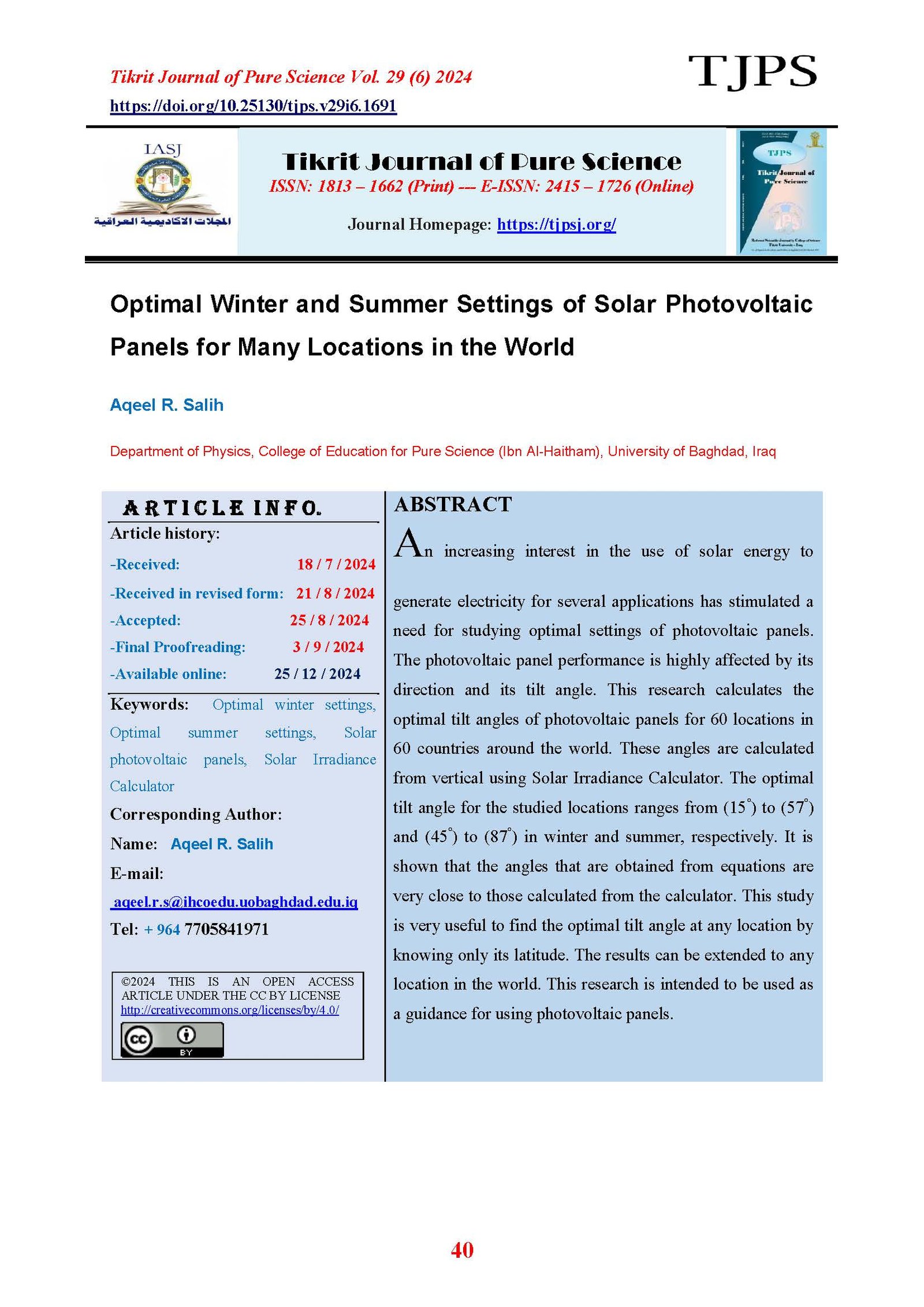Optimal Winter and Summer Settings of Solar Photovoltaic Panels for Many Locations in the World
Main Article Content
Abstract
An increasing interest in the use of solar energy to generate electricity for several applications has stimulated a need for studying optimal settings of photovoltaic panels. The photovoltaic panel performance is highly affected by its direction and its tilt angle. This research calculates the optimal tilt angles of photovoltaic panels for 60 locations in 60 countries around the world. These angles are calculated from vertical using Solar Irradiance Calculator. The optimal tilt angle for the studied locations ranges from (15°) to (57°) and (45°) to (87°) in winter and summer, respectively. It is shown that the angles that are obtained from equations are very close to those calculated from the calculator. This study is very useful to find the optimal tilt angle at any location by knowing only its latitude. The results can be extended to any location in the world. This research is intended to be used as a guidance for using photovoltaic panels
Article Details

This work is licensed under a Creative Commons Attribution 4.0 International License.
Tikrit Journal of Pure Science is licensed under the Creative Commons Attribution 4.0 International License, which allows users to copy, create extracts, abstracts, and new works from the article, alter and revise the article, and make commercial use of the article (including reuse and/or resale of the article by commercial entities), provided the user gives appropriate credit (with a link to the formal publication through the relevant DOI), provides a link to the license, indicates if changes were made, and the licensor is not represented as endorsing the use made of the work. The authors hold the copyright for their published work on the Tikrit J. Pure Sci. website, while Tikrit J. Pure Sci. is responsible for appreciate citation of their work, which is released under CC-BY-4.0, enabling the unrestricted use, distribution, and reproduction of an article in any medium, provided that the original work is properly cited.
References
[1] Soysal OA, Soysal HS. Energy for sustainable society: from resources to users. John Wiley & Sons; 2020 May 18. https://doi.org/10.1002/9781119561330
[2] Patel MR, Beik O. Wind and solar power systems: design, analysis, and operation. 3rd ed. CRC Press; 2021 Mar 23. https://doi.org/10.1201/9781003042952
[3] Sørensen B, Breeze P, Storvick T, Yang S-T, da Rosa AV, Gupta HK et al. Renewable energy focus handbook. Academic Press; 2009. https://forskning.ruc.dk/en/publications/renewable-energy-focus-handbook
[4] Goswami DY. Principles of solar engineering. 4th ed. CRC Press; 2023 Sep 6. https://doi.org/10.1201/9781003244387
[5] Zhou L, Yang L. Optimization of installing angles of photovoltaic panels to maximize solar radiation by simulated annealing algorithm. IOP Conference Series: Materials Science and Engineering. 2018 Dec 13; 452 (3): 032004. https://doi.org/10.1088/1757-899X/452/3/032004
[6] Al Garni HZ, Awasthi A, Wright D. Optimal orientation angles for maximizing energy yield for solar PV in Saudi Arabia. Renewable energy. 2019 Apr 1; 133: 538-50. https://doi.org/10.1016/j.renene.2018.10.048
[7] Dogaheh ZR, Puig V. Tilt angle optimization of photovoltaic panels. In 2019 6th International Conference on Control, Decision and Information Technologies (CoDIT) 2019 Apr 23; (pp. 1847-52). IEEE. https://doi.org/10.1109/CoDIT.2019.8820549
[8] Nfaoui M, El-Hami K. Optimal tilt angle and orientation for solar photovoltaic arrays: case of Settat city in Morocco. International Journal of Ambient Energy. 2020 Jan 28; 41 (2): 214-23. https://doi.org/10.1080/01430750.2018.1451375
[9] Hua Y, He W, Liu P. Optimum tilt angles of solar panels: a case study for Gansu province, northwest China. Applied Solar Energy. 2020 Sep; 56 (5): 388-96. https://doi.org/10.3103/S0003701X20050060
[10] Barbón A, Ayuso PF, Bayón L, Silva CA. A comparative study between racking systems for photovoltaic power systems. Renewable Energy. 2021 Dec; 180: 424–37. https://doi.org/10.1016/j.renene.2021.08.065
[11] Khan PW, Byun Y-C, Lee S-J. Optimal photovoltaic panel direction and tilt angle prediction using stacking ensemble learning. Frontiers in Energy Research. 2022 Apr 27; 10: 865413. https://doi.org/10.3389/fenrg.2022.865413
[12] Al-Shohani WAM, Khaleel AJ, Dakkama HJ, Ahmed AQ. Optimum tilt angle of the photovoltaic modules in Baghdad, Iraq. Applied Solar Energy. 2022 Aug; 58 (4): 517–25. https://doi.org/10.3103/S0003701X22040028
[13] Abdelaal AK, El-Fergany A. Estimation of optimal tilt angles for photovoltaic panels in Egypt with experimental verifications. Scientific Reports. 2023 Feb 25; 13: 3268. https://doi.org/10.1038/s41598-023-30375-8
[14] Mahmood YH, Atallah FS, Tawfeeq SS. Fabrication and study of solar panel tracking system. Tikrit Journal of Pure Science. 2018 Apr 1; 23 (1): 123–7. https://doi.org/10.25130/tjps.v23i1.489
[15] Mahmood YH, Atallah FS, Youssef AF. Studying the weather condition affecting on solar panel efficiency. Tikrit Journal of Pure Science. 2020 Mar 17; 25 (3): 98–102. https://doi.org/10.25130/tjps.v25i3.255
[16] Salim KD. Studying the effect of light intensity and the dust on efficiency of silicon solar cell. Tikrit Journal of Pure Science. 2021 Sep 7; 26 (4): 68–70. https://doi.org/10.25130/tjps.v26i4.164
[17] IRENA. Renewable capacity statistics 2024. International Renewable Energy Agency (IRENA); 2024. https://www.irena.org/
[18] Kutscher CF, Milford JB, Kreith F. Principles of sustainable energy systems. 3rd ed. Taylor and Francis; 2019. https://doi.org/10.1201/b21404
[19] Fletcher G. The electrician's guide to photovoltaic system installation. Cengage; 2014. https://www.cengage.uk/c/the-electrician-s-guide-to-photovoltaic-system-installation-1e-fletcher/9781111639969/
[20] Lin Y-H, Lan J, Nan C. Oxide Thermoelectric materials: from basic principles to applications. John Wiley & Sons; 2019. https://doi.org/10.1002/9783527807550
[21] Belu R. Fundamentals and source characteristics of renewable energy systems. Taylor and Francis; 2020. https://doi.org/10.1201/9780429297281
[22] Jamil M, Rizwan M, Kothari DP. Grid integration of solar photovoltaic systems. Taylor and Francis; 2018. https://doi.org/10.1201/9781315156347
[23] DGS. Planning and installing photovoltaic systems: a guide for installers, architects and engineers. 3rd ed. The German Energy Society (DGS); 2013. https://doi.org/10.4324/9781849776998
[24] Boxwell M. Solar electricity handbook: a simple, practical guide to solar energy-designing and installing solar PV systems. 14th ed. Greenstream; 2021. https://www.amazon.com/dp/1907670750
[25] Chang K-T. Introduction to geographic information systems. 9th ed. McGraw-Hill; 2019. https://www.mheducation.com/highered/product/introduction-geographic-information-systems-chang/M9781259929649.html
[26] Lazar J, Feng JH, Hochheiser H. Research methods in human-computer interaction. 2nd ed. Elsevier; 2017. https://www.sciencedirect.com/book/9780128053904/
[27] Berman JJ. Data simplification: taming information with open-source tools. Elsevier; 2016. https://www.sciencedirect.com/book/9780128037812/
[28] United Nations. Department of economic and social affairs, population division. World urbanization prospects: the 2018 revision. https://www.un.org/development/desa/pd/
